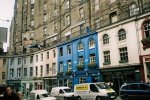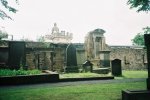At the beginning of this blog I said I love Ireland yet there is not a single post about it. I just want to make it right, so you fall in love with this country like I did. Why am I mentioning it right now? Well because Ireland and Scotland have quite a lot in common. The Giant’s Causeway… actually I thought about the accent, friendliness of the people and way of living.
Edinburgh was magical for me. I went alone just for a couple of days and I would like to go back. The pictures are not great. I didn’t have a digital camera at the time and the weather wasn’t the best so it’s truly better to see it with your own eyes. Short overview of my stay: Arrived and checked in to awsome hostel with great paintings on the walls and striptease in the middle of the night in the middle of our dormitory. Sightseeing of the city with Sandeman’s New Europe free tour (recommended), Ghost Tour finished in a local pub, sightseeing whiskey distillery, Literary pub tour (the best tour I have ever been on), one day tour around the castles of Scotland and Wallace Statue (I so wanted to see Loch Ness and wander the highlands but I would rather have more time to do it, rent a car and just be able to enjoy the sights as long as I want to rather than on a strict timeline).
Let’s the magic begin…
Walking the narrow streets of the old town you can feel the dumpy and dangerous atmosphere of ‘Dr Jekyll and Mr Hyde’ as well as magical frame of Harry Potter, you can easily imagine the witch hunts as well as murders comitted to obtain corpses for medical students… Burke and Hare, The World’s End Murders, David Hume, Sir Arthur Conan Doyle, Walter Scott, Irvine Welsh… drinking, thinking, writing it’s all very alive here.
With every day, and from both sides of my intelligence, the moral and the intellectual, I thus drew steadily nearer to the truth, by whose partial discovery I have been doomed to such a dreadful shipwreck: that man is not truly one, but truly two.
R.L. Stevenson
Edinburgh history is littered with colourful characters, some of whom were merely eccentric, while others committed devilish deeds that remain notorious to this day. Let me introduce you to some of them.
 Deacon Brodie is one of Edinburgh’s most infamous villains. A respected cabinet-maker with a well-to-do clientele in 1780s Edinburgh. Brodie turned to burglary to support a lavish lifestyle. He and his gang copied keys to public buildings and plundered them under cover of darkness. Brodie was caught, sentenced to death, and was hanged near St Giles Kirk on the Royal Mile. It is said Robert Louis Stevenson used Brodie as an inspiration for Dr Jekyll and Mr Hyde.
Deacon Brodie is one of Edinburgh’s most infamous villains. A respected cabinet-maker with a well-to-do clientele in 1780s Edinburgh. Brodie turned to burglary to support a lavish lifestyle. He and his gang copied keys to public buildings and plundered them under cover of darkness. Brodie was caught, sentenced to death, and was hanged near St Giles Kirk on the Royal Mile. It is said Robert Louis Stevenson used Brodie as an inspiration for Dr Jekyll and Mr Hyde.
The ‘body-snatchers’ William Burke and William Hare terrorised Edinburgh, carrying out a series of murders between 1827 and 1828. The bodies of their 17 victims were sold to Dr Robert Knox, a private anatomy lecturer in the City who needed specimens for his students to dissect. When Burke and Hare were eventually found out, Hare testified against his friend, and was released. Burke was hanged for his crimes, before having his body publicly dissected at the Edinburgh Medical College.
 The Lone Piper. As the story goes, a few hundred years ago secret tunnels were discovered deep underground, running from the castle to other places in the city. A piper boy was sent down to investigate, instructed to constantly play his pipes, so those above could chart his progress through the tunnels. When the playing suddenly stopped, they went and searched for the piper boy but he had vanished. His ghostly pipes can still be heard playing in the castle to this day, as he eternally walks the dark tunnels beneath.
The Lone Piper. As the story goes, a few hundred years ago secret tunnels were discovered deep underground, running from the castle to other places in the city. A piper boy was sent down to investigate, instructed to constantly play his pipes, so those above could chart his progress through the tunnels. When the playing suddenly stopped, they went and searched for the piper boy but he had vanished. His ghostly pipes can still be heard playing in the castle to this day, as he eternally walks the dark tunnels beneath.
Ian Hamilton, Gavin Vernon, Kay Matheson, and Alan Stuart – on Christmas Day 1950 a group of four Scottish students took the Stone of Scone (or Stone of Destiny, The Coronation Stone) from Westminster Abbey for return to Scotland. The stone was damaged and divided into two parts. After hiding the greater part of the stone with travellers in Kent for a few days, they risked the road blocks on the border and returned to Scotland with this piece, which they had hidden in the back of a borrowed car, along with a new accomplice John Josselyn. Although an Englishman, Josselyn, then a student at  Glasgow University, was a Scottish Nationalist. And rather ironically and probably unknown to him at the time, Edward I (who captured the Stone in 1296 and took it to Westminster Abbey) was his 21st great grandfather. You can watch the whole story in a movie called Stone od Destiny. The Coronation Stone, is an oblong block of red sandstone, used for centuries in the coronation of the monarchs of Scotland and later the monarchs of England, Great Britain and the United Kingdom. Historically, the artifact was kept at the now-ruined Scone Abbey in Scone, near Perth, Scotland. It is also known as Jacob’s Pillow Stone and the Tanist Stone, and in Scottish Gaelic clach-na-cinneamhain.
Glasgow University, was a Scottish Nationalist. And rather ironically and probably unknown to him at the time, Edward I (who captured the Stone in 1296 and took it to Westminster Abbey) was his 21st great grandfather. You can watch the whole story in a movie called Stone od Destiny. The Coronation Stone, is an oblong block of red sandstone, used for centuries in the coronation of the monarchs of Scotland and later the monarchs of England, Great Britain and the United Kingdom. Historically, the artifact was kept at the now-ruined Scone Abbey in Scone, near Perth, Scotland. It is also known as Jacob’s Pillow Stone and the Tanist Stone, and in Scottish Gaelic clach-na-cinneamhain.
Greyfriars Bobby a Skye Terrier believed to have been the companion of ‘Auld Jock’ Gray a local policeman. After Gray died in 1858 Bobby is reputed to have stayed loyal to his master sleeping close to his grave in Greyfriars Kirkyard nearby for fourteen years until his own death in 1872. His life size statue is located at the junction of Candlemaker Row and George IV Bridge opposite the new National Museum of Scotland.
 Maggie Dickson was a fish wife from Musselburgh. She fell pregnant while her husband was working away and when she gave birth to the stillborn baby she hid the evidence. For this crime she was sentenced to by hung in Edinburgh’s Grassmarket. She was hung for the required length of time and had her legs pulled to see if there were any signs of life. There was none so she was nailed in her coffin and her relatives began the long journey back to Musselburgh with the coffin in tow. On stopping for refreshments at Inveresk, noises were heard coming from the coffin, it was opened and Maggie Dickson was found to be alive. The official view was that no one could be hanged twice so she was free to continue with her life. She ran an ale house and mothered many children before dying from old age. She was known as Half Hangit Maggie and nowadays a pub bearing her name stands near the site of her failed execution.
Maggie Dickson was a fish wife from Musselburgh. She fell pregnant while her husband was working away and when she gave birth to the stillborn baby she hid the evidence. For this crime she was sentenced to by hung in Edinburgh’s Grassmarket. She was hung for the required length of time and had her legs pulled to see if there were any signs of life. There was none so she was nailed in her coffin and her relatives began the long journey back to Musselburgh with the coffin in tow. On stopping for refreshments at Inveresk, noises were heard coming from the coffin, it was opened and Maggie Dickson was found to be alive. The official view was that no one could be hanged twice so she was free to continue with her life. She ran an ale house and mothered many children before dying from old age. She was known as Half Hangit Maggie and nowadays a pub bearing her name stands near the site of her failed execution.
Other stories:
In the castle’s Great Hall there is a little barred window high above the fireplace; in Scotland these holes are called ‘laird’s lugs’ (Lord’s ears). In the early 16th century King James IV would spy through this little hole to eavesdrop on meetings taking place in the Hall below. So effective are ‘laird’s lugs,’ as a means of eavesdropping that when Gorbachev planned his visit to the castle for a conference in 1984, the Soviet national security insisted the hole be bricked over.
 Edinburgh Castle is also home to Mons Meg cannon, the enormous medieval supergun made around 1449. This cannon fired huge solid stone cannon balls- three times the size of your head. Each weighed 400 pounds and could be fired as far as 2 mile! The ritual of firinf the One O’Clock Gun still continues to this day, which takes place precisely at one o’ clock on every day of the week (except for Sunday). This ritual began in 1861 as a time signal for ships. For 26 years the Gun was fired by a man nick-named ‘Tam the Gun’ until he died in 2005. Now the Gun is fired everyday by ‘Shannon the Cannon.’
Edinburgh Castle is also home to Mons Meg cannon, the enormous medieval supergun made around 1449. This cannon fired huge solid stone cannon balls- three times the size of your head. Each weighed 400 pounds and could be fired as far as 2 mile! The ritual of firinf the One O’Clock Gun still continues to this day, which takes place precisely at one o’ clock on every day of the week (except for Sunday). This ritual began in 1861 as a time signal for ships. For 26 years the Gun was fired by a man nick-named ‘Tam the Gun’ until he died in 2005. Now the Gun is fired everyday by ‘Shannon the Cannon.’
In 1836 5 boys made a very unusual discovery in a cave on Arthur’s Seat. They found 17 miniature coffins with carved wooden figures inside, all dressed differently, and arranged in 3 tiers with 8 coffins on each (1 on the final tier suggesting it wasn’t completed). The fist tier was decayed, the second less so and the third seemed recent. No one knows what they were for or who carved and put them there. So many theories abound from witchcraft to sailors charms. My favourite is that they were carved by a shoemaker who knew Burk and Hare and each figure represents one of their victims. But we will never know. They were held in a private collection until 1901 when they were gifted to the Museum of Scotland. Only 8 have survived – the rest decayed – and can be seen today at the Royal Museum in Chambers Street.
In the XVI th century the country was obbsessed with witchcraft and the Nor’ Loch proved a perfect spot for ‘Trial by Douking’ (Ducking).This would consist of a suspected witch having her thumbs and toes tied together and ducked on a specially designed ‘stool’ twice into the Loch. If she sank and drowned she would be found innocent….but dead! but if she was unfortunate enough to float and survive drowning she would be found guilty and burned at the stake on Castlehill. The decision was taken to drain the Loch in 1759 and the valley is now Princes Street Gardens.
 The World’s End is something of an Edinburgh institution. It lies on the south side of High Street at its junction with St Mary’s Street. Edinburgh built a stone wall around the city to protect it, the Flodden Wall. Parts of the wall can still be seen, and its course ran along the west side of St Mary’s Street underneath where the World’s End is now built (the pub reuses the foundations of the wall). The main gate on this side of the city was on High Street here, and its outline is marked in the street by brass coloured cobbles. But anyway you could easely leave the city but in order to come back you had to pay a tax. Most of people couldn’t afford to pay it and that’s why it was the end of the World for them.
The World’s End is something of an Edinburgh institution. It lies on the south side of High Street at its junction with St Mary’s Street. Edinburgh built a stone wall around the city to protect it, the Flodden Wall. Parts of the wall can still be seen, and its course ran along the west side of St Mary’s Street underneath where the World’s End is now built (the pub reuses the foundations of the wall). The main gate on this side of the city was on High Street here, and its outline is marked in the street by brass coloured cobbles. But anyway you could easely leave the city but in order to come back you had to pay a tax. Most of people couldn’t afford to pay it and that’s why it was the end of the World for them.
There is so much more to Edinburgh, museums, science, Royal Mile. I tried to give you just a glimpse on the part I love the most – stories. Enjoy the slideshow:

